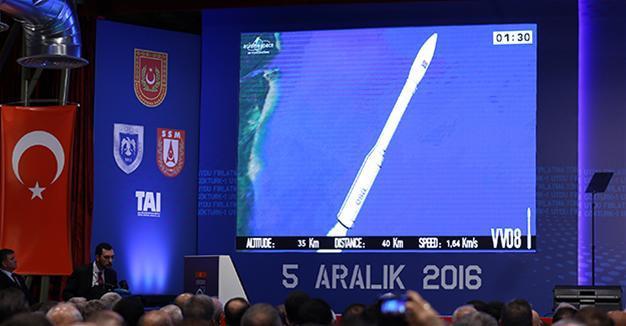Turkey launches space satellite GÖKTÜRK-1
ANKARA

AA photo
Turkey launched the GÖKTÜRK-1 satellite on Dec. 5 to provide high-definition satellite images for both civilian and military purposes, the Turkish Chief of Staff announced.
The satellite, which was launched from Spaceport in French Guiana, is a Turkish military project that is being conducted with the partnership of Turkish firms such as Turkish Aerospace Industries (TAI), ASELSAN, TÜBİTAK and ROKETSAN under the auspices of Thales Alenia Space (TAS-F).
The satellite, with a mass of 1,070 kilograms without fuel, has a high-definition optical camera and is designed to circulate on an orbit synchronized with the sun. It is expected to capture more than 60,000 images per year.
In its statement, the Turkish Armed Forces said the satellite was the second military vehicle to be launched after GÖKTÜRK-2 in 2012. The satellite will fulfill the Turkish army’s need for intelligence without being “restricted by geographical boundaries.”
The satellite’s primary mission will be to answer the needs of the Turkish Armed Forces, especially in the fight against terrorism. The satellite cost Turkey 261.5 million euros and is expected to have a lifespan of seven years. The satellite is expected to be used primarily in Turkey’s eastern and southeastern regions, as well as in Iraq and Syria. It is also expected to be used in military operations conducted in Syria.
The statement added that, along with GÖKTÜRK-2, the new satellite, with its downloading pace, maneuvering abilities and advanced ground system characteristics, will increase Turkey’s power in space.
It was added that the integration and environmental testing phase of the satellite was conducted in Turkey’s first national Spacecraft Assembly, Integration and Test (AIT) Center.
Meanwhile speaking during a special event organized in Ankara to watch the launching of GÖKTÜRK-1, Turkish President Recep Tayyip Erdoğan said the satellite would provide close-up vision as close as half a meter.
The current satellite in use, GÖKTÜRK-2, gets high-resolution images up to a distance of 2.5 meters.
Underlining that the level of national contribution to the production of the satellite was 20 percent, Erdoğan said the opposite should be the case for the next satellite to be sent to space.
“With good planning and right choices, we should provide a defense industry in which we will be self-sufficient as soon as possible,” said Erdoğan.
He also criticized Turkey’s NATO allies for not providing the country with drones that it wants to purchase, signaling his unease about, what he argues, the lack of military support from the community.
“Now we are producing [them] for much cheaper,” said Erdoğan.
